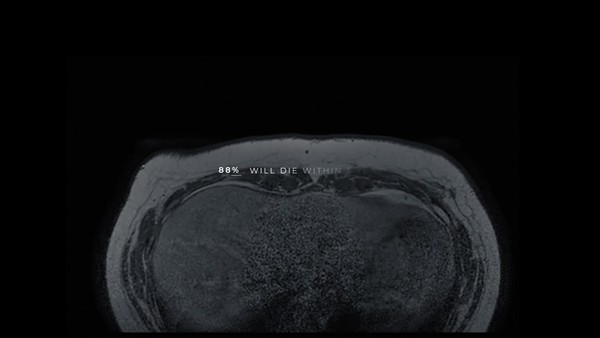Creative Data > Creative Data
PAINTINGS OF HOPE
VMLY&R HEALTH, Madrid / GILEAD ONCOLOGY / 2023


Overview
Credits
OVERVIEW
Why is this work relevant for Creative Data?
Is relevant because Paintings of Hope uses real data about TNmBC (a disease ignored by politicians and society) collected during interviews to patients to turn the data into something that everybody is pleased to look frontally: art.
Gilead wanted to launch a drug against TNmBC. But in Spain, the law takes 500 days to approve access to new treatments, meaning that thousands of TNmBC patients die waiting for treatment.
With AI and voice analytics we turned the feelings of three patients about the situation of their disease into coded data. Then a robot transformed it into an art.
Background
Triple Negative Metastatic Breast Cancer (TNmBC) affects 5,000 women each year in Spain. However, it remains ignored by society, politicians and decision-makers.
While in Europe it takes 180 days to approve new drugs, in Spain it takes 500 days. Why? Because the National Health System prefers to fund drugs for diseases with a better prognosis. This makes thousands of TNmBC patients die waiting for treatment. Despite the hopeless situation, patients don't lose their hope to change the law to have a faster access to treatment.
Gilead wanted to launch a new drug against TNmBC to change patient's situation. But first, Gilead needed to change the law.
That is why we launched Paintings of Hope, to show politicians through real data collected from patients and then transformed into art the reality of TNmBC, making decision-makers and politicians see that they're part of the problem, but also part of the solution.
Describe the creative idea / data solution
Paintings of Hope transformed the feelings of three TNmBC patients into art thanks to AI, voice analytics and robotics, changing patients situations and helping to modify the law. Patient now, thanks to the campaign, have a faster access to a treatment for their condition.
Three patients were interviewed about the unfair situation of their condition in Spain to collect data about TNmBC. We camptured their feeling from their voices during the interviews and transformed them into coded data thanks to a voice analytics software. Then, the coded data was sent to a robot trained to interpret it and transform it into art.
Paintings of Hope is a nine canvases collection that was exhibit in hospitals, public places and even The Spanish Parliament, showing to society and politicians the real data of TNmBC in a way that everybody empathized with and mobilized people to change the law for 180 days.
Describe the data driven strategy
The numbers and statistics are there: 5000 young women are diagnosed every year in Spain and the 85% will die within 180 days if they don't receive a treatment immediately.
But this data is very tough. That is why nobody, not even politicians a decision-makers, want to see it. For this reason the situation of TNmBC patients didn't change until Paintings of Hope was launched.
We gathered real data from patients testimonies and extracted their feelings thanks to voice analytics. The feelings were transform into coded data and interpreted by a robot trained to convert data into art.
Paintings of Hope was exhibited in hospitals, medical congresses, transportation hubs and in The Spanish Parliament, where politicians and decision-makers this time had to see frontally the reality of the patients. This was key, because thanks to the exhibition in The Parliament, politicians change the law to 180 days access.
Describe the creative use of data, or how the data enhanced the creative output
Paintings of Hope collected real data about TNmBC in Spain through the voice analysis of three patients testimonies and then transformed that data into an art collection. All thanks to a robot trained during six months to be able to convert pure data into emotional and beautiful art.
Paintings of Hope is compound by nine canvases that reflected the journey of the patients throw their condition and the urgent necessity of the patients to the law be changed so they can have a faster access to new drugs.
Paintings of Hope toured around Spain being exhibited in Hospitals, medical congresses and even made to the Spanish Parliament where finally the politicians looked frontally the reality of TNmBC and changed the law to guarantee a 180 days access to treatment for these patients.
List the data driven results
Results >
+134 MM REACH
+690 MEDIA IMPACTS
+45K HCPs FROM 150 DIFFERENT COUNTRIES REACHED
+ € 11.68 MM EARNED MEDIA
But the most important result is that after the launch of Paintings of Hope, the change happened, and the hope returned to patients when The Spanish Parliament approved a 180-day access to drugs for TNmBC.
The change of the law supposed for Gilead that finally could launch a new drug and reach faster to these women. Today, thousands of them are being treated with Gilead's drug and their life expectancy is now better and longer than before Paintings of Hope.
Is there any cultural context that would help the jury understand how this work was perceived by people in the country where it ran?
The needs of TNmBC patients in Spain are very different from those in other countries as there were no treatments available to address their pathology. In contrast, in other regions, these medicines are accessible to all patients in only 180 days.
It is this situation of inequality that has led to the development of Paintings of Hoe to vindicate the neglect of this cancer in Spain and how innovation is the great hope for patients to transform their reality and change the law for a faster access to treatment.
Today, thanks to Paintings of Hope, metastatic triple negative breast cancer patients have a new law that has transformed their lives and, also, that of their environment and that of the medical-scientific community.
More Entries from Data Visualisation in Creative Data
24 items
More Entries from VMLY&R HEALTH
16 items


